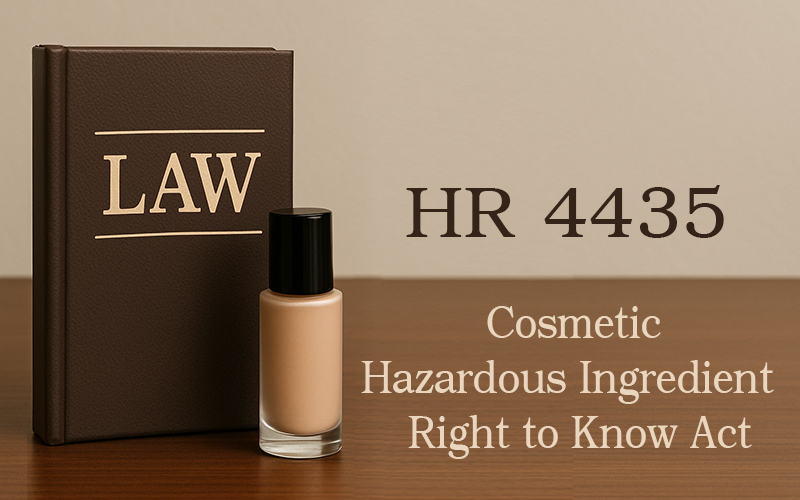The third bill included in the Safer Beauty Bill Package is H.R. 4435 – Cosmetic Hazardous Ingredient Right to Know Act, introduced by Reps. Schakowsky and Matsui.
According to the sponsors, this bill requires website and product label disclosure of secret, unlabeled, and often toxic chemicals in our personal care products. It is modeled after California’s Cosmetic Right to Know Act, which I covered here: California Allergen Reporting.
Master List of Harmful or Toxic Substances
The bill requires that the FDA create and maintain a Master List of every conceivable potentially harmful cosmetic ingredient substance or component. The Master List would become the basis for specific cosmetic product label and disclosure requirements.
The FDA won’t have to invent the list. The bill requires that any substance on any one of 22 different lists be included in the Master List. While there is likely to be a lot of overlap, that’s still a LOT of components. The referenced lists are:
- Chemicals for which a reference dose or reference concentration has been developed based on neurotoxicity in the Environmental Protection Agency’s Integrated Risk Information System.
- Chemicals that are identified as carcinogenic to humans, likely to be carcinogenic to humans, or as group A, B1, or B2 carcinogens, in the Environmental Protection Agency’s Integrated Risk Information System.
- Persistent, bioaccumulative, and toxic Priority Chemicals identified by the Environmental Protection Agency’s National Waste Minimization Program as of February 22, 2016.
- Chemicals that are identified in volumes 1 through 4 of the Reports on Human Exposure to Environmental Chemicals issued by the Centers for Disease Control and Prevention (and any updates to such reports).
- Toxic pollutants listed under section 20 307(a)(1) of the Federal Water Pollution Control Act and priority pollutants identified in appendix A to part 423 of title 40, Code of Federal Regulations (or successor regulations).
- Chemicals classified as ‘Persistent, Bioaccumulative and Toxic’ by the Toxics Release Inventory published by the Environmental Protection Agency pursuant to section 313 of the Emergency Planning and Community Right-to-Know Act of 1986.
- Chemicals that are identified in the Agency for Toxic Substances and Disease Registry’s Toxic Substances Portal.
- Chemicals that are hazardous substances, as such term is defined in section 101(14) of the Comprehensive Environmental Response, Compensation, and Liability Act of 1980.
- Reproductive and developmental toxicants identified by monographs issued by the National Toxicology Program Center for the Evaluation of Risks to Human Reproduction.
- Chemicals that are identified as known to be, or reasonably anticipated to be human carcinogens by the most recent Report on Carcinogens prepared by the National Toxicology Program pursuant to section 301(b)(4) of the Public Health Service Act.
- Chemicals identified as persistent, bioaccumulative, and toxic (PBT) chemicals by the Department of Ecology of the State of Washington (WAC 173–333 (2006)).
- Chemicals specified in Chapter 6.6 of the California Safe Drinking Water and Toxic Enforcement Act of 1986 (sections 25249.5 through 25249.14 of the California Health and Safety Code), List of Reproductive and Developmental Toxicants and Carcinogens.
- Chemicals for which primary maximum contaminant levels have been established and adopted under section 64431, 64444, or 64444.5 of division 22 of title 26 of the California Code of Regulations and chemicals for which notification levels, as defined in section 116455 of the California Health and Safety Code, have been established by the California State Water Resources Control Board.
- Chemicals identified as toxic air contaminants under section 93000 or 93001 of title 17 of the California Code of Regulations.
- Substances classified as carcinogens, mutagens or reproductive toxicants in Appendices 1 through 6 of Annex XVII to Regulation (EC) No. 1907/2006 of the European Union’s Registration, Evaluation, Authorisation and Restriction of Chemicals (REACH) law, as revised by the Commission Regulation (EU) 2020/2096 of 15 December 2020.
- Chemicals included in the European Union Candidate List of Substances of Very High Concern in accordance with Article 59 of the REACH Regulation (EC) No. 1907/2006 on the basis of fulfilling the criteria defined in Article 57(f) for endocrine disrupting properties.
- Chemicals included in such European Chemicals Agency Candidate List of Substances of Very High Concern on the basis of fulfilling the criteria defined in Article 57(d), Article 57(e), or Article 57(f) for persistent, bioaccumulative and toxic, or very persistent and very bioaccumulative, properties.
- Chemicals classified by the European Union in Annex VI to Regulation (EC) No. 1272/2008 as respiratory sensitizer category 1.
- Chemicals that are identified as persistent, bioaccumulative, and inherently toxic to the environment by the Canadian Environmental Protection Act Environmental Registry Domestic Substances List pursuant to subsection 66(1) of the Canadian Environmental Protection Act, 1999.
- Group 1, 2A, or 2B carcinogens identified by the International Agency for Research on Cancer of the World Health Organization.
- Chemicals that are identified on Part A of the list of Chemicals for Priority Action prepared by the Oslo and Paris Conventions for the Protection of the Marine Environment of the North-East Atlantic.
- Chemicals that are skin sensitizers and irritants classified by Regulation (EC) No 1272/2008 of the European Parliament and of the Council of 16 December 2008 on classification, labelling and packaging of substances and mixtures, amending and repealing Directives 67/548/EEC and 1999/45/EC, and amending Regulation (EC) No 1907/2006.
It’s important to note here that the specification is for the substances on these lists at the time the bill is enacted AND any subsequent updates. For example, if the EU adds a new item to their list of skin sensitizers (#22 above) it would automatically be added to the FDA’s master list.
The Master List is supposed to compiled within 6 months of the enactment of the bill (if or when that happens). It must be posted to the FDA website, and there must be a way for cosmetic manufacturers and other interested parties to receive a copy of the list and any subsequent updates.
Fragrance and Flavor Components
Right now, the components of a fragrance or flavor do not need to be disclosed; you can just put “fragrance” or “flavor” in the ingredient declaration (as appropriate).
That would change with this bill. This bill requires disclosure of all components of fragrances and flavors, and failure to do so makes the product misbranded if that information is not included on the label.
This part of the bill is going to get major push-back from the fragrance and flavor industries. Right now, their formulations are generally protected by keeping them as trade secrets. They aren’t usually patented, becaused then they would have to disclose the scent formulation–and they probably wouldn’t qualify for patents anyway as they aren’t sufficiently a “new innovation.”
There are currently some lawsuits over protections of fragrances as “copyright,” but they are a long way from being resolved. They generally are regarding the subject of “dups”–where one fragrance company tries to make a cheaper knock-off duplicate of a high-end fragrance.
So far, no cosmetic bill has been able to require full disclosure of all components because of the huge financial cost to fragrance manufacturers and perfumers. The closest so far is that fragrance allergens must be disclosed. That’s already in place: in the EU they must be disclosed on product labels; in California, cosmetic products with fragrance allergens sold in California must be reported to the state; and the FDA is supposed to come up with a list of fragrance allergens that must be disclosed on cosmetic product labels in the US.
New Label Requirements
The bill requires the listing of the ingredient present in the cosmetic, including each flavor or fragrance component, to be listed in descending order of predominance. The change here is that it specifically says components of the flavor and fragrance, rather than allowing the use of the generic terms “flavor” or “fragrance.”
It’s interesting to note that we don’t currently have a LAW that mandates the ingredient declaration at all. It’s in REGULATIONS, based on the authority (but not requirement) of the Fair Packaging and Labeling Act. The use of “flavor” and “fragrance” is in the regulations as well. This bill would change the law (which would then require that the regulations were appropriately updated as well).
Finally, when the cosmetic contains any ingredient specified in the Master List (of harmful ingredients) then the statement, “For health impacts related to any ingredients in this product, visit: www.____.” The URL must go to a page on the brand owners site. (The brand owner is the person/business listed on the label.)
These new label requirements would go into effect 2 years after the enactment of the bill. That gives plenty of time to update your labels, IF this bill makes it through the lawmaking process and becomes law (which is by no means certain).
Website Requirements
On the website, located at the URL address listed on the label, the brand owner must have:
- A full listing of each ingredient present in the cosmetic, including each fragrance or flavor ingredient, in descending order of predominance.
- The functional purpose served by each fragrance or flavor ingredient.
- When an ingredient is included on the Master List (of harmful ingredients), it must have a link to the URL of any list (used to compile the Master List, as discussed above) that the ingredient is included in.
- A link to the hazard communication safety data sheet for any cosmetic intended for professional use.
The wording of the requirements in the bill is a little confusing (bad grammar).
On the website, the data has to be in electronically readable format (so not in an image or pdf, probably).
The brand owner must make the information available to any relevant internet vendor. (I believe this is addressing sales on sites such as Amazon, WalMart or Etsy.)
Regulations
If passed, this bill will require substantial updates to the regulations covering cosmetic labeling and other requirements. Even with the long-ish timelines for implementation (1 -2 years after the bill is passed), one wonders if the FDA will have the time, resources, and inclination to go through the rule-making process. They haven’t updated any cosmetic regulations for a LONG time. Even with MoCRA, the regulations haven’t been updated. They issued guidances, but never updated the actual regulations.
Some of the provisions in the bill are complicated or unclear (or both), so a delay in issuing the clarifying regulations would be unfortunate.
Potential Impact of Bill
Huge.
This bill, if passed, will have a huge impact on small businesses and handcrafted cosmetic makers.
There will be additional information required on the label. That means keeping track of that information AND making sure there is room for it on the label. For very small labels, that could pose problems.
There will also be a huge impact in terms of additional paperwork and website management.
The one possible mitigating factor is that most small businesses and handcrafters don’t use any (or not very many) ingredients that might be on one of the 22 lists. Fragrance and flavor components and essential oils will be the most likely sources of ingredients that will need special record-keeping, product label updates, and website pages.
In my opinion, there is very little possibility of this bill getting passed. The potential cost to industry will be a major deterrent, as will industry push-back and the current general move toward fewer regulations.


Leave a Reply